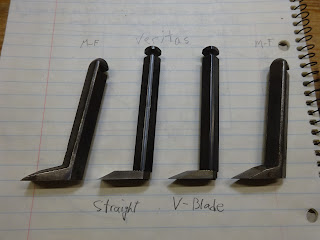After recently adding a Millers Falls #67 router plane to my kit, I looked at the differences between it and the Veritas router plane. More specifically, I looked at the irons and the things that affect the iron function.
 |
| Millers Falls #67 on left, Veritas right |
The first thing you notice is the difference in the angle from the shaft to the cutting portion. On the Veritas it is approximately 5° and on the MF it's about 10°.
 |
| MF straight, Veritas straight, Veritas V cutter and MF V cutter (bottoms of the irons are aligned with a horizontal line on the sheet of paper) |
The next thing was the grinding angle of the straight cutters relative to their unbeveled flat faces. This was about 38° on the MF (original or modified, who knows?) and 22-23° on the Veritas. The shafts of the cutters are positioned vertically in both router planes. This means that the angle that the cutting edge is presented to the wood is much steeper for the MF (~48°!) than the Veritas (~33°).
The next obvious thing is that the Veritas irons are a bit taller than the MF. And there's a little less material above the adjustment slot on the Veritas (1/8" versus 1/4" for the MF). These things combine to give the Veritas quite a bit more depth of cut.
 |
| About 5/8" max depth of cut for the MF (with 3/8" base attached) |
Note that if the adjuster nut of the MF router is turned upside down, you lose almost 3/8" depth of cut. At first I didn't know which was the intended orientation. Pictures on the internet show both orientations. But a sketch in an old ad on the Miller Falls Planes website showed the knurled larger part on bottom, and that makes sense given the depth of cut issue.
 |
| Adjustment nut in what I believe is normal orientation (with scant 3/8" auxiliary base, gives 5/8" max cutting depth) |
 |
| Adjuster nut inverted - gives almost 3/8" less depth of cut (with 3/8" base, gives just over 1/4" max depth) |
The Veritas has just over a 1" total depth of cut - even with the 1/2" auxiliary base. But there is a catch. It also has a stop collar for when you want the plane to stop cutting at a certain depth.
 |
| On the Veritas, the 3/8" tall stop collar is adjusted with the middle of 3 brass knurled nuts |
With that stop collar not removed and the 1/2" auxiliary base installed, the depth of cut is limited to about 5/8". Without those limitations, the Veritas can cut 1 1/2" deep! The max without any impediments for the MF is about 15/16".
Not that that's a problem - when do we need to cut a housing that deep? And if you do, it's probably larger and could be done with a chisel.
There is one other difference between the two that I wasn't even going to mention, but I'm sure I'd get taken to task about it. The Veritas irons are two pieces: the bottom cutter portion can be removed for MUCH more easy sharpening. That is a huge advantage, as we all know how awkward it can be to sharpen a standard router iron.
All for now. Next time I'll present a rant about the "V", or spear point router plane cutters.
You are correct, the knurled cutter adjuster nut is supposed to be larger part on the bottom. Curious to hear your rant about the spear point cutter, it is the one i used the most. The two part cutters was an improvement from Stanley. Veritas cutters fit Stanley planes, do they fit your MF?
ReplyDeleteBob
Huh! I didn't realize Stanley made a 2-part iron. Yes, the Veritas cutter fits the MF router and the MF cutter fits the Veritas router. But I have noticed one problem with the MF: the cutter locking mechanism can lock different irons slightly off vertical, making the cutting edge not parallel with the sole. That was true when I put he Veritas iron into the MF plane. It was also true when I turned the MF iron around in the MF plane (to use it bullnose style). I've got to be very careful to make sure the cutting edge is parallel with the sole when I use it.
DeleteVeritas has well thought out tools.
ReplyDeleteThat they do! They had over 100 years of Stanley and other maker tools to draw knowledge from. And they do it well.
Delete